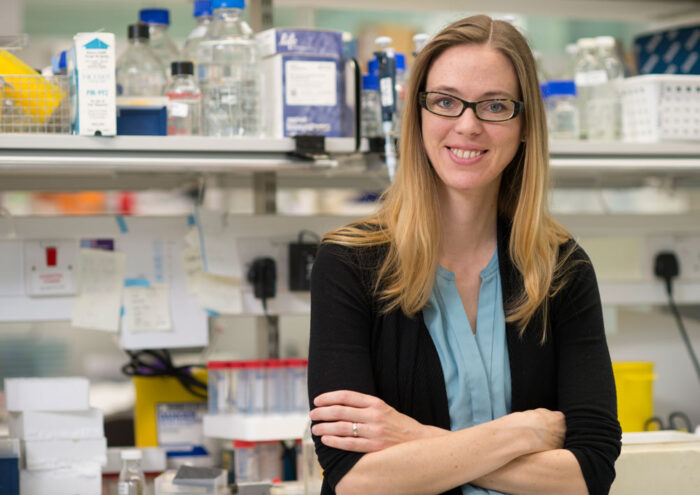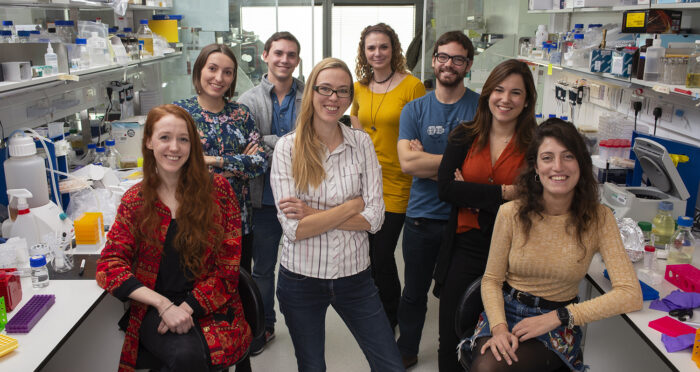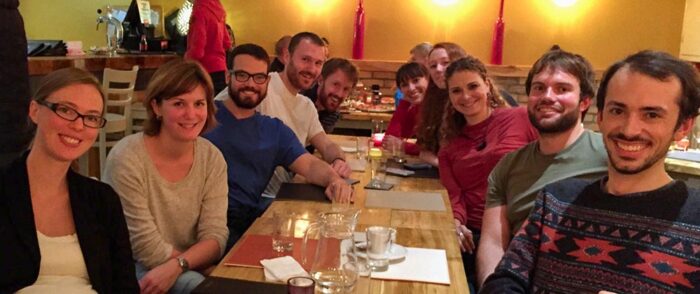Next in our series of Group Leader profiles based on interviews with science writer and LMB alumna, Kathy Weston, is a profile of Madeline Lancaster, a Group Leader in the LMB’s Cell Biology Division.

As often happens with great science, Madeline Lancaster stumbled across the discovery that has shaped her career almost completely by mistake. As a very new postdoc in Jürgen Knoblich’s lab in Vienna, she was trying to get mouse neural epithelial cells to form neural rosettes, but couldn’t get the cells to sit down on the dish. Instead of throwing the cultures out, she took a look at the little balls of cells floating in suspension, and saw to her amazement that they’d self-organised into 3D spherical structures surrounding an inner fluid-filled space. “It was the first thing I saw in the microscope”, she says, “and it’s burned in my memory because it was really beautiful”. Fresh from a PhD on brain development in Joseph Gleeson’s lab in San Diego, Madeline realised that what she was seeing looked a lot like tiny neural tube-like structures, and recognised the importance of what she’d accidentally done.
Of course, that first experiment was just the start. Madeline ended up moving the technology over into human stem cells to make self-organising cerebral organoids, sometimes referred to as mini-brains, which contain the rudiments of key parts of the human brain, including the hippocampus and prefrontal cortex. “There were actually a couple of years of working out the right formulation for the media, getting the right timing and so on”, says Madeline, “to go from that little neural tube like ball, to what we can actually call a brain organoid. That was really the hard part!” The mini-brains are a big advance for the neuroscience field, and seven years on from publication, their importance as in vitro models of the brain in health and disease are now well-established.
Madeline says that a fair amount of luck was involved in her discovery, not least that the rosetting experiment didn’t work properly. It also turned out that stem cell people had already noticed the floating balls of cells, but because they didn’t have Madeline’s background in developmental biology had dismissed them as annoying failures. And then there was the timing: “The fact that those ‘failed’ experiments were done very early in my postdoc meant that I didn’t have a project to focus on”, she says, “if I had made the same observation three years in, I wouldn’t have been able to follow it up as I’d have been wrapping up other stuff. And a lot of credit also goes to Jürgen, as he trusted me enough to leave me alone and see what would happen”.
Mini-brains are most suited to answer questions about tissue architecture and development and Madeline’s lab is interested in how a brain decides how big it should be – how neuron number is determined, and what events help regulate neural stem cell fate decisions. “A lot of that comes back to the tissue architecture; how the cells are positioned relative to one another, and what kind of signalling events are happening between them”, she explains.

The lab’s ultimate aim is to understand what’s unique about human brain development, and to get to grips with that they are currently generating brain organoids from humans, primates and rodents. “The nice thing about having this kind of in vitro approach is we’re not limited in terms of what kinds of animals we can look at”, says Madeline. “If we can get cells from an animal we can reprogramme them to pluripotent stem cells and use them to make brain organoids. We’re interested in establishing the general rules of mammalian brain size determination and the way the brain is built, and to see what’s special to humans, what’s present in all primates but not in others – those kinds of questions.”
They’re already seeing differences that make sense, particularly those that reflect size differences in the actual brains of the animals. “Human brain organoids are bigger than those of chimpanzees, and mouse brain organoids are tiny”, says Madeline, “but what’s striking is that these differences arise much earlier than I expected. There are differences in shape and tissue architecture as well as cell number – questions that are really basic to cell biology. We’re still doing pretty simple observational things at the moment, but I’m amazed at what we’ve already learnt. It speaks to the power of these organoids – that they are fully self-organising and following their own intrinsic developmental programs.”
What’s it like working in such a high profile field with such potential for sensationalism? “I’m very much trying not to sensationalise it, of course”, says Madeline. “Fortunately, my interactions with the public have all been very positive – the minute you show them an actual brain organoid they realise it’s not thinking about much!”
Madeline came to the LMB for a mix of reasons. Her husband is Italian and works in the pharmaceutical industry, and as they wanted to stay in Europe, Cambridge, with its strengths in both industry and academia, was perfect. “There’s a question that I always ask myself”, says Madeline. “A couple of years down the line when I’ve made this decision and I’ve moved, will I still love science?” So far, she thinks the LMB was the right choice for her. “What I really like about the LMB is that it gives you the intellectual freedom to stretch a little and do things that are hard,” she says, “and I also still enjoy being at the bench, particularly as it allows me to train the people in my lab.”

“If I was in the US right now I wouldn’t be doing what I’m doing,” Madeline adds. “There are people in my field in the US using my method and every single one of them is working on translational research trying to model neurological diseases. That’s great, but there’s also basic biology we can use these things to model, and nobody’s getting funding for that, in the US at least. You can’t say you do curiosity-driven research in the US now – it would be very hard to justify the therapeutic benefit of working with gorilla brain organoids.”
Running a lab has been fun so far, Madeline says, especially the freedom of being her own boss: “just being able to do what I care about and knowing that the LMB trusts me to think about these questions is great.” And she’s not felt isolated either: “Luckily, I was the third of three new women group leaders to start within a year, and that immediately made it better,” she says, “although I miss the camaraderie of being a postdoc – I get along well with my lab but it’s never going to be the same, as in the end I’m still the boss.”
With two successful parents who both have experience of academia, Madeline’s current lifestyle is the family norm, something she realises has given her a great advantage. “My strongest influence is my Dad, who’s also a scientist”, she says. “My postdoc and PhD advisors have been really important in helping me navigate the modern scientific world, but the confidence to communicate with journal editors, write grants and so on was natural to me, thanks to him. I know some women give up on academia due to their fear of not succeeding, and I’ve never had to deal with those sorts of doubt.”
With two children aged seven and three, life is very busy. As a major voice in the field, Madeline is much in demand, but limits her travelling to two chunks of time in the spring and autumn, which also suits her experimental schedule. When deciding what to accept, Madeline says she weighs the time cost in terms of the potential benefit: “if someone asks me to collaborate, or go to a meeting or give a seminar, if it’s of no benefit to me or the lab I say no. Time is precious – you have a limited amount of time on this earth so why not enjoy it?”
In the end, like most successful academics, science is much more than just a job for Madeline. “I don’t have a career – this is me playing around in the lab just having fun! I’d love to get a permanent position at the LMB, but if that doesn’t happen, wherever I go, I’ll still carry on doing the best science that I can”, she says. “As long as I still have my lab and can do my research the way I want to do it, wherever I am on that ladder, I’ll be happy.”